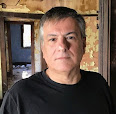
On an impulse last week, I picked up the new 50th anniversary edition of Alfred Hitchcock's NORTH BY NORTHWEST. Hadn't seen it in decades, and then only on commercial television, so the restored 2-disc DVD set gave me an excuse to take my first look at it in years.
It's a great movie. Or maybe that should be, it's a great movie.
That's because, watching it, it occurs to me it's as close to pure cinema as most films get. It's a confection that works only as a movie. As a novel, it would make no sense. As a television series, it would seem redundant and silly (though shows like CHUCK and BURN NOTICE owe a debt to it). On radio, it would be absurd. But as a film, it's an almost perfect merger of images and sound, expertly used to evoke emotions. It's funny, it's suspenseful, it's beautiful to look at and, despite its two-hour-plus length, it moves like lightning.
On the face of it, Hitchcock's tale of an advertising executive (Cary Grant) mistaken for a spy and chased cross-country by enemy agents, police and his own government, bears no resemblance to reality. In the first place, it's Cary Grant, not exactly the American Everyman. Secondly, the plot mechanisms that launch the chase are outlandish bordering on ludicrous. An assassination in the U.N. lobby is nearly a parody in itself, and fifteen minutes into the film, when the villains have poured a bottle of bourbon into Grant and set him behind the wheel of a sports car careening along a cliffside Long Island road, one wonders why he doesn't just pull over to the shoulder. But they're both great sequences, rich with color and detail and enhanced by Bernard Herrman's iconic score (for an earlier variation on it, check out his orchestration for Nicholas Ray's 1952 noir ON DANGEROUS GROUND).
The same applies to the film's most famous sequence, in which a crop-dusting plane chases Grant's Roger Thornhill along an empty Indiana road. It's one of the great scenes in cinema, despite the fact it makes little sense. Why lure a man out into the middle of nowhere and then try to kill him with a plane, of all things? (Not to mention, if the plane had actually hit him, it would likely have crashed). Certainly a bullet in the head and a quick drop in Lake Michigan would have been a more efficient - and cost-effective - solution. And what does "North by Northwest" mean anyway? The chase takes Thornhill south before it takes him north, though it does end, memorably, at Mount Rushmore (actually a cleverly painted studio backdrop) in South Dakota.
But in the end, none of this matters. You could say NXNW is greater than the sum of its parts, except those parts are all pretty great on their own. Eva Marie Saint is luminous as Eve Kendall, Thornhill's love interest/nemesis, delivering some pretty risque (for 1959) sexual innuendo without ever breaking eye contact. James Mason is smooth and charming as the chief villain, Martin Landau subtly menacing as his henchman, and Ernest Lehman's script is full of sparkling dialogue ("That wasn't very sporting," Mason's character deadpans at the finale. "Using real bullets.").
Few films utilized the VistaVision/Technicolor process as well as it was used here, and this restored/remastered print is a sheer pleasure to look at, with its vibrant colors and perfectly framed shots, whether they be wide masters (the many action scenes) or detail inserts (Landau's eerily blue eyes). The art direction and wardrobe are practically characters themselves - check out Eva Marie Saint's black and red dress in the Chicago auction house scene. And when was the last time you saw bright green used so well in a title sequence?
The special features on the set are excellent as well, including lengthy documentaries about Grant (a frank and forthright one), Hitchcock and the making of the film. Also included is a feature-length commentary by screenwriter Lehman retained from an earlier release (he died in 2005 at age 89). Newark, N.J., native Eva Marie Saint appears prominently in all the features and is still going strong at age 85 (she gave an interview to the San Francisco Chronicle about the film on Friday, and there's another recent one on Kim Morgan's Sunset Gun blog.).
In some ways, NXNW marked the end of Hitchcock's "Old Hollywood" period. It was his final film (of four) with Grant, and though he would continue to use soon-to-be-major stars (Paul Newman, Sean Connery) in his remaining seven films, it's the last gasp of the man who made TO CATCH A THIEF, REAR WINDOW and other thrillers steeped in Hollywood glamor. The next year, he would get down and dirty with PSYCHO.





No comments:
Post a Comment